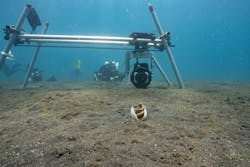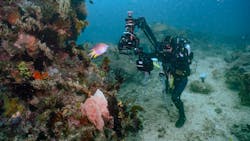"Secrets of the Octopus" by James Cameron is a Scientific Triumph
What you'll learn:
- How the scientific community captured “firsts” when filming octopus.
- Cameras used to film the series.
"Secrets of the Octopus" is a remarkable documentary series that follows marine biologists, citizen scientists, and divers into the mysterious world of octopi, showcasing their complex behaviors, intelligence, and interaction with their environment. James Cameron’s series stands out not only for its captivating subject matter, but also for its innovative use of technology in underwater filmmaking. 8K and 6K cameras were deployed along with video processing to bring out the natural effects of the animals.
Here are some quick questions and answers with the director of photography, Adam Geiger:
During the making of "Secrets of the Octopus," what was the size of your crew?
The film crew for "Secrets of the Octopus" varied by location, from a team as small as four up to 12 people. On most shoots, I had a second experienced cinematographer working with me. A few times, we had concurrent shoots on opposite sides of the world, and we enlisted talented local camerapersons to capture specific sequences.
No matter where we were filming, it took a dedicated, highly professional team to make it all possible, including dive supervisors on the surface, an underwater team of both safety divers watching the camera team and diving camera assistants to ferry around/change out/reload the six camera systems we often used on a dive. At every remote location, it was all hands on deck to maintain the diving, camera, and lighting equipment, preparing it all for hours of use each day.
What was the extent of the lighting being natural versus the need to set up lighting?
My goal is to always make a scene feel natural. In almost every sequence in “Secrets of the Octopus,” we used underwater lights to enhance color and contrast. By day, that could mean one small light underwater to restore warm colors in the foreground, or at night, big lights on the surface to create a moonlit underwater seascape. The exceptions were a few scenes in water only a few feet deep, where lighting was impractical.
What cinema camera was used?
My talented team used a variety of cameras to record in ultra-high definition. For maximum resolution and flexibility in the grade, we recorded in RAW formats: RED Helium and Sony A1 in 8K, Sony F5 and A7Siii in 4K, and ZCam in 6K.
What was the ratio of usable footage?
Octopus can change their shape, color, and texture faster than the blink of an eye. And their behavior in the wild has hardly been studied. So, we needed to capture a huge amount of very high-quality footage to reveal the story and new science of each octopus. Ultimately, the shoot ratio was around 40:1.
What was the best time of day to shoot?
Octopi spend a lot of their time resting in a den — it's the safest place to be in between their hunting trips. The shoots were based on when a particular species would be most active. The Day octopus, as its name suggests, was active during sunlight hours. But the blue-ringed octopus is busiest at night. We often started our 4+ hour dives after 9 pm, like in the cold waters of the Southern Ocean. Over time, we learned when individual octopus were out and about. Like most natural history filming, it's the animal who dictates when the cameras roll.
The production was kind enough to give us at Electronic Design some unique clips from the show. The following two clips eerily show how intelligent octopi seem to be, very calculated:
I fully recommend the series. Currently available as a new National Geographic series on Disney+, FYI, the third episode has some behind-the-scenes with James Cameron.



